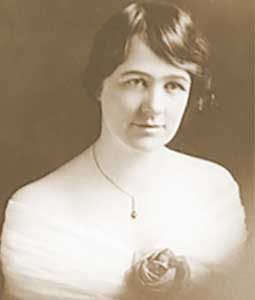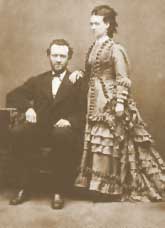
Courtesy Aileen Schlager
JESSIE CALLAHAN MAHONEY
The information below has been compiled from a variety of sources. If the reader has access to information that can be documented and that will correct or add to this woman’s biographical information, please contact the Nevada Women’s History Project.
At A Glance:
Born: May 17, 1887
Died: June 12, 1956
Maiden Name: Callahan (sometimes spelled Callaghan)
Race/Nationality/Ethnic Background: Caucasian (Irish)
Marrried: William J. Mahoney
Children: Four (one son, three daughters)
Primary City and County of Residence and Work:
Dunphy, Beowawe (Eureka Co.)
Major Fields of Work: Local government (elected member, Eureka County Commission), Ranching
Other Role Identities: Wife, Mother, Teacher, Postmistress
Jessie Callahan was born in Austin, Nevada on May 17, 1887. Her parents were Eliza Farrell and Dan Callahan. Eliza had been born in Buenos Aires where her parents landed after leaving Ireland; they went around the Horn in a clipper ship and arrived in San Francisco to live. Jessie’s father, Dan, was born in County Kerry, Ireland and came to Nevada in 1862, later homesteading his own land near Austin in Grass Valley.

Callaghan, Farrell, Schlager
An unfortunate accident with a team of horses took Dan Callahan’s life when Jessie was three months old, so she never knew him. Her mother, Eliza, was left with a heavily mortgaged ranch and four children. Eliza’s two brothers loaned her money to pay off the ranch. She managed by selling beef, grain, pork and vegetables to the Cortez Mine community. The Indians who lived near the ranch were very helpful. Two years later, Eliza married Hugh McAfee who had been working on ranches in the area.
Jessie attended school in Austin, then St. Mary’s of the Wasatch Academy in Salt Lake City, then was a teacher for a short time at Waltis’ ranch near Grass Valley. She met William Mahoney, who had been born in County Cork, Ireland and came to America where he worked in Reese River Valley for Pat Walsh, then did freighting of ore from the mines with big mule teams from the Dean Ranch. Finally, he became the superintendent of a huge estate owned by an Irishman from California named William Dunphy who had started acquiring Rock Creek and Humboldt River lands in 1870 with a partner named Hildreth. By 1877, the property totalled well over 100,000 acres extending from Argenta near Battle Mountain to Stampede on Maggie Creek north of Carlin. By 1884, Dunphy operated with 23 irons (brands), the best known being the T Lazy S. Various headquarters for the ranching operation included the Blue House Ranch in Lander County, the Star, the DU, and the White House Ranches in Eureka County, and Simon’s Ranch, Coyote Creek, Red House and Stampede in Elko County.
Jessie married William in 1915 in a wedding ceremony at a Catholic cathedral in San Francisco, then went to live with him at the White House ranch at Dunphy.
That same year, an Elko paper reported that the Dunphy Estate, now managed by Dan Callahan, encompassed 151,000 acres, 8,000 cattle and horses and other personal property to a value of approximately $2,000,000.
Jessie got a saddle for a wedding present and loved riding, ranching and the out-of-doors. Jessie managed the household affairs, including the Chinese cooks who prepared meals for the “hired help” who were branding or calving or working on hay crews (sometimes as many as forty men). For housekeeping, she had help from Indian women who lived on the ranch.
Jessie also was responsible for much of the entertaining of visitors to the ranch: business people, other ranchers, cattle buyers, miners, relatives, people from Austin, people from San Francisco, clergy traveling from Salt Lake to Reno. And then there were politicians like Tasker Oddie, Pat McCarran, and Judge Eather from Eureka.
According to Nevada’s Northeast Frontier, co-authored by Edna Patterson, Louise A. Ulph, and Victor Goodwin, members of the Dunphy family occasionally visited Nevada on ranch inspections, “driving over the property by fringed surrey and blooded horses. Usually after a week roughing it, they returned to San Francisco life. Once a month the superintendent picked up a strong box containing gold coin shipped from San Francisco to Beowawe. He took it by buggy to the ranch to pay employees.”
At one point Jessie’s special project was the raising of turkeys and geese which were then butchered and sold. Another responsibility for a time was being postmistress for the Dunphy post office – seeing that miners, prospectors, trappers, railroad workers and people on other ranches got their mail.
Jessie and William had four children: Aileen, Mary, Dan, and Theresa. William was gone a lot, managing the various ranch properties. For each birth, Jessie would travel to San Francisco prior to the anticipated date and stay a reasonable time afterwards. Later, she took the children to live in San Francisco for a year because Aileen’s rheumatic fever required that they be near medical care.
From the oral history of daughter Aileen: “Wherever my mother was, was a lovely place to be. No matter what she was doing, she put magic in it; my father, too…the type of people who come into the room and lights and music go on.”
Jessie especially loved the wild roses that bloom along the Humboldt River in June. Aileen remembers her mother putting bouquets of them on the dining table. Having grown up on the banks of Callahan Creek, Jessie enjoyed being near the river and frequently took the children fishing.
Jessie was also a strong advocate for higher education, especially for women. According to Aileen, “We always received books as gifts, and had magazines and several newspapers at home. Mother continued to be a teacher at heart, encouraging everyone in their studies.”
In 1938 the Dunphy estate owners split up their holdings. William no longer had his job as superintendent and he and Jessie moved off the Dunphy Ranch in 1939 to a ranch they had purchased near Beowawe. It was much smaller, but it was their own and they could do with it as they chose. Now they had their own cattle and their own brand. Dan and Theresa helped in the operation of the ranch.
Eureka County politics was always an interest of William and Jessie. The Mahoneys participated in Fourth of July parades, political rallies, and supported Democratic candidates. William was elected to the Eureka County Commission in the late 1930s and early 1940s. When he died in 1945, Jessie was appointed by Governor Carville to finish out his term, and was then elected for two more terms on her own.
(When asked if her mother liked being a commissioner, Aileen replied: “Yes. As I say, this was the woman who was always running things from behind the scenes. Where they say women stayed home…they knew all the business. Mother was feminine and she was very bright. I remember her pouring coffee around the table and the men were talking cow prices and tonnage for hay. She already had done it in her head while the boys were figuring it out. And she wore earrings and a ruffled apron. You never knew there was a whole battle fleet right inside her.”)
After William’s death, Jessie took over running the Mahoney ranch at Beowawe with Dan and Theresa. Mary lived there, too, while teaching school in Beowawe. Aileen had married Wes Schlager and was living and teaching in Elko. According to Aileen, “Jessie had always wanted a ranch of her own, instead of managing someone else’s property. She especially loved the ranch at Beowawe, with its wide open views. She took a knowledgeable interest in every aspect of the ranch and cattle operation and was a very shrewd rancher…We used to ride together and walk through the fields close to the house looking for the turkeys’ nests. Mama loved picnics and was always coming up with an excuse to have one. Some of my best memories are of the times we cooked steaks over an open campfire and had watermelon under the willows by the Humboldt River.”
Jessie’s son, Dan, was killed in an auto accident while coming home from Elko with buck rake teeth in August of 1952. Jessie and her daughter, Theresa, carried on with the ranching operation and continued to improve the place.
Jessie Mahoney died on June 12, 1956 and was buried in Elko; on her tombstone is an inscription that says Manos in prosperitate, major in adversitate, or “great in prosperity, but greater in adversity.”
Biographical sketch by Jean Ford, primarily from an oral history by Aileen Mahoney Schlager
Sources of Information:
- Eureka Memories. Eureka, NV: Eureka County History Project, 1993.
- Knudtsen, Molly Flagg. “The Callaghan House: Grass Valley, Nevada.” Elko: Northeastern Nevada Historical Society Quarterly, 93-3.
- Patterson, Edna, Louise A. Ulph, Victor Goodwin. Nevada’s Northeast Frontier. Sparks, NV: Western Printing and Publishing, 1969.
